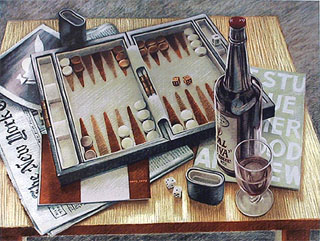|
| Magriel's NYT Columns |
 The Bar Point House of Backgammon is marking its first anniversary this month with the second annual Bar Point Open on Oct. 15. This event, which was successful last year, is one of several tournaments regularly sponsored by the club.
The Bar Point House of Backgammon is marking its first anniversary this month with the second annual Bar Point Open on Oct. 15. This event, which was successful last year, is one of several tournaments regularly sponsored by the club.
The Bar Point, at 69 West 14th Street, is also the New York City representative of the Metropolitan Backgammon Association and so participates in interclub matches. Indeed, backgammon enthusiasts find the club attractive because of its wide range of backgammon activities — social play, stake play and chouettes, as well as free beginners’ lessons.
The diagrammed position occurred during causal play at the Bar Point last week and deceived Black, a seasoned player. Black was way ahead in the race but he had two exposed outfield blots to bring home.
|
| Black to play 6-2. |
Black’s strategy backfired. White next rolled a 4-2 and correctly played 3/7*/9, hitting Black; Black stayed out. White hit Black’s second blot and eventually closed Black out. Black’s misfortune continued — he was gammoned.
The correct play is 13/5, safetying the blot on the mid-point. Granted, by not making use of duplication Black is somewhat more likely to be hit next roll (24 combinations out of 36 will hit him, instead of 17). However, Black has more important considerations than reducing his immediate danger.
|
|
|
- By playing 17/15, 13/7, Black leaves two blots. If he is hit, there is an excellent chance his other blot will also be hit before he can come in and safety it. White would then be a strong favorite to win the game and even possibly a gammon (as, in fact, actually happened).
- By correctly playing 13/5, Black leaves only one blot. Now if he is hit, the consequences will be far less severe. White obviously cannot hit a second man; nor can he double Black. Thus Black can play the game out until the end, and will probably have many opportunities to escape with his last man. In fact, Black will still be a slight favorite even after being hit!
Black’s knowledge of duplication enabled him to minimize shots. However, Black was led astray — a little knowledge proved dangerous. In general, it is important to remember that minimizing blots, not shots, may have first priority. Duplication is certainly an important tactical principle. However, it does not take into account long-range strategic implications. Use duplication as a tool, but don’t let it dictate overall strategy.
Rollout
 Tom Keith 2013 |
|
Money play Black owns 2-cube Black rolls 6-2 1296 games with VR Checker play: 2-ply Cube play: 3-ply Red |
| 6-2: | Game | G | BG | Equity | ||||
| 1 | 13/5 |
W L |
.5150 .4850 |
.1322 .0308 |
.0013 .0009 | +0.2866 |

| (b) |
| 2 | 17/15, 13/7 |
W L |
.5013 .4987 |
.1090 .1084 |
.0008 .0030 | +0.1789 | (0.1077) | (a) |

|
|

